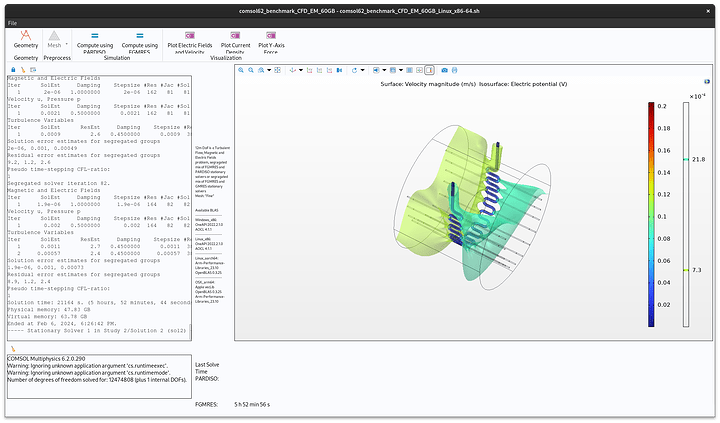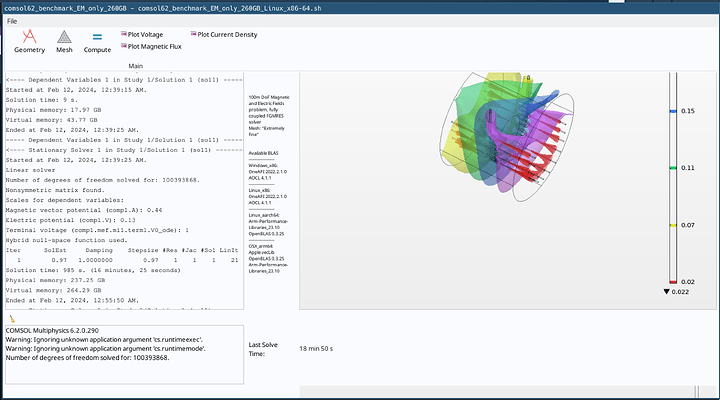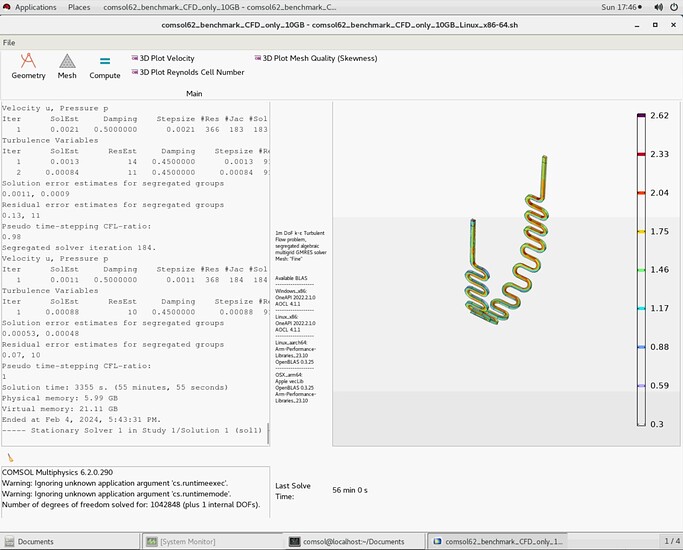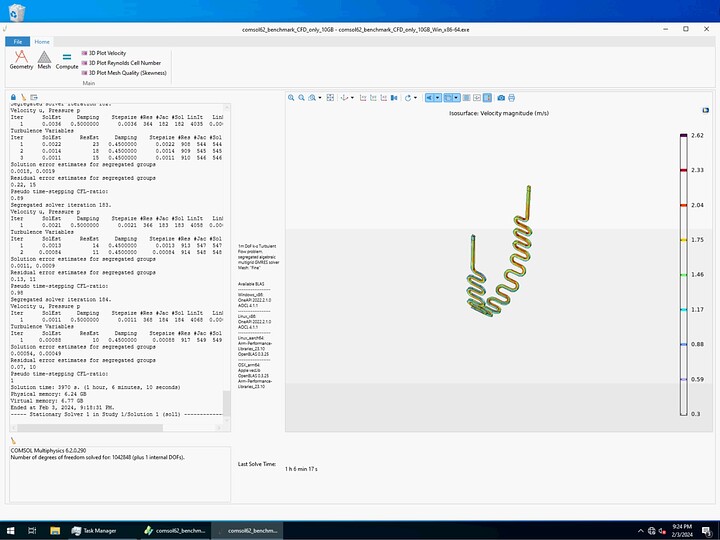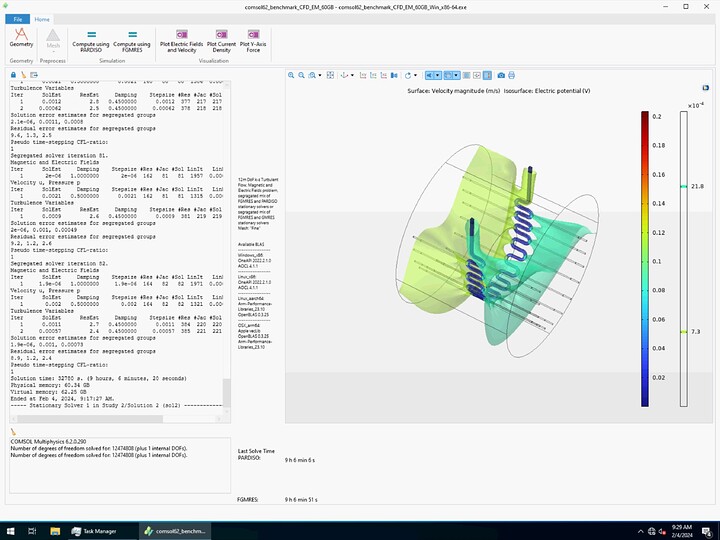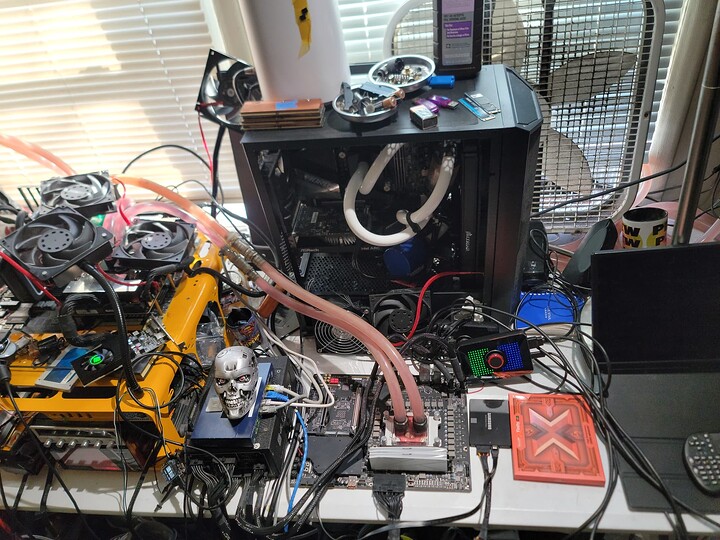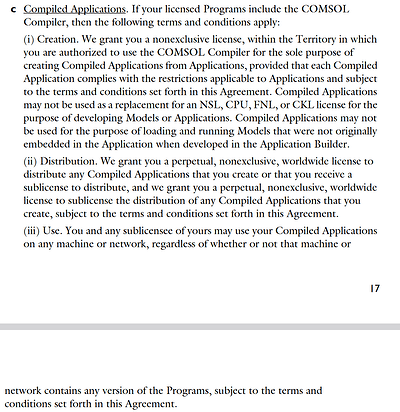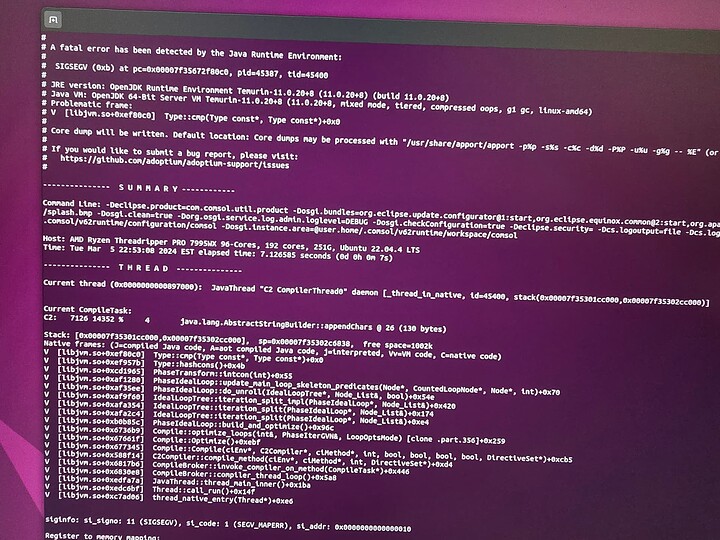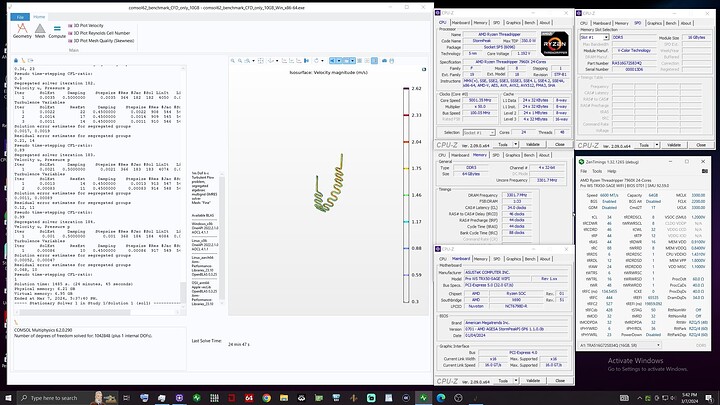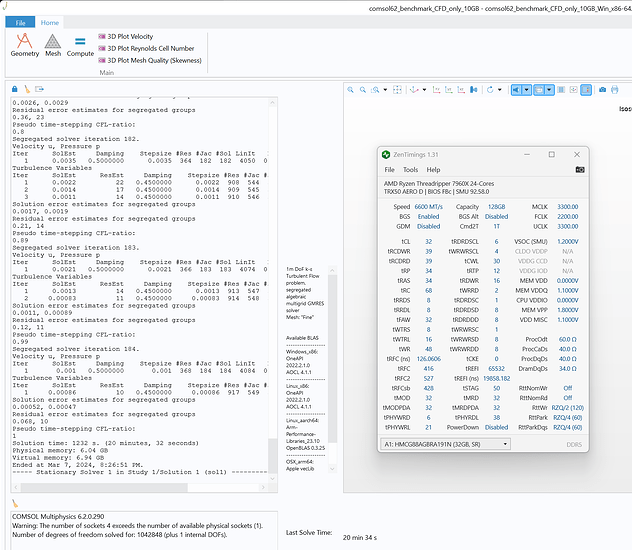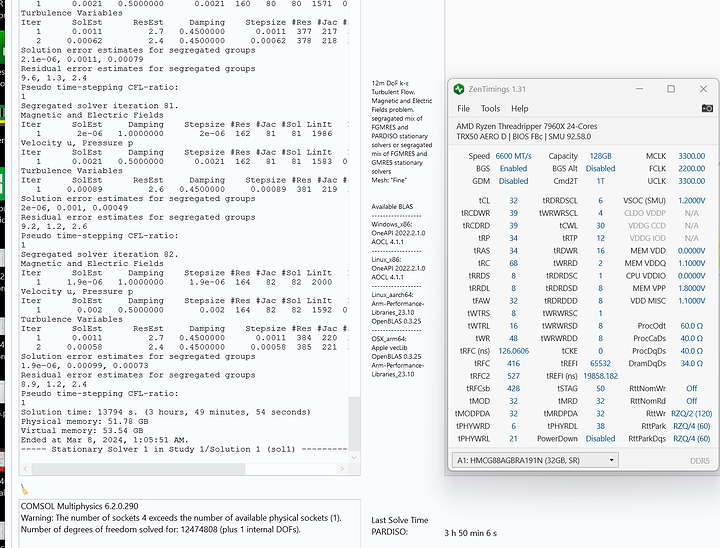CFD-EM 5:52:56… Same specs
I could get mine to run at 5600MHz stable (y-cruncher for 12 hours, no errors) but it was running way hotter than I’m comfortable with, so I’ve reverted to 4800 MT/s for now. I may try 5600 MT/s again after I get some heatsink for it.
I re-ran EM only again, this time boosting to around ~3.6 GHz although with 4800 MT/s (it’s set to 4 GHz all cores, but 450W PL brought it down to 3.6 GHz). It managed to cut ~1m40s off my initial result, now at 18m50s.
I just watched the Asianometry video on the $35 billion Ansys deal and was kind of impressed with how many comments about multiphysics FEA there were; people are becoming aware that CFD is just the tip of the iceberg with simulation.
At any rate I finished my testing on an older Dell M630 computer to compare Windows versus Linux performance and Linux was a little bit faster, about 15%:
RHEL 7.4 Performance:
CFD-only:
CFD-EM:
Windows 10 19044.1466 Performance:
CFD-only:
CFD-EM:
Can anyone compare results between 7975wx and 7970x? I’m struggling to decide which platform I should build. According to https://www.reddit.com/r/threadripper/comments/1azmkvg/comparing_threadripper_7000_memory_bandwidth_for/ the main factor limiting memory bandwidth is the bus between the I/O die and the CCD. For a 4 CCD configuration on the Pro platform you will never get 360GB/s memory read speed, you will get around 240GB/s. This is not impressive improvement over the 160 GB/s on the non-pro platform, given the price difference.
@eousphoros ran the CFD-only benchmark on a 7975WX and got very good results, a little better than the 8 channel, 16 core Xeon-W.
I’m not sure that reddit thread’s OP is using sound logic. Passmark’s threaded memory bandwidth test is being heavily influenced by L2/L3 cache speed rather than pure DRAM speed (because the test isn’t using a “deep” enough dataset), check out @MSIMAX_OVERCLOCKER memory threaded score:
It’s superior to the 24 core 8 channel WRX90 threadripper (7965wx) memory performance but on the TRX50 (passmark superior). L2/L3 speed is definitely going to be influenced by the number of chiplets, but DRAM speed isn’t.
In reality TRX50 seems to be about 160-180GB/s DRAM bandwidth under ideal condition and WRX90 seems to be about 230-260GB/s. I’m referencing memory copy speed since it is the most analogous metric for any kind of memory intensive simulation (as opposed to pure read or write).
There seems to be a diminishing returns situation with the 8 channel platform over the 4 channel platform.
@MSIMAX_OVERCLOCKER can we ask you to run CFD-only model from OP post for better understanding difference between pro and non-pro platforms in close to real word computational workloads? This can help many people make the right choice and possibly save few thousand bucks.
Doing 8700g review and testing currently and what is the link to the software in question
edit found it lol
I will try to give a shot on the CFD one on some old machines (xeon v2 to v4) to get reference points that users might already have, as well as a Xeon scalable.
It is FE discretisation with comsol even for CFD, isn’t it ?
I’m curious how do you process to make this, Comsol doesn’t require licensing for benching ?
Is it replicable on Ansys or Siemens product ?
Might be good to do the same with open foam (for CFD), or over open CAE applications, to simplify benchmarking for the guys that happen to have cool hardware but don’t run these.
@twin_savage , I share your interst about multiphysics, power requierement and repartition might be different from CFD (and even in CFD differents simulations might scale differently).
I was wondering how so last week.
Correct, using FE for all physics involved is currently (imo) the only way to interface arbitrarily different physics together efficiently.
The other cool thing about FE is you can use higher order discretization on different physics to “refine” the results without trying to tweak the mesh; you can even use different discreetizations within different physics within multiphysics.
for example:
The CFD-only model is linearly discretized for both the flow and turbulence variables, the EM-only model is quadratically discretized for magnetic vector potential and electric field variables, and the CFD-EM model is a mix of discretization order of the 4 variables above.
Basically by dissecting one of the example application models that Comsol put up on their website and putting my problem into it with some very basic tweaking. There should be a .mph file in that folder that shows all the construction, but you need Comsol and associated license to open it.
I suspect because Comsol is European and not American they have sane licensing schemes. The gist of it is: as long as you don’t make a compiled application that replaces the use of the actual Comsol seat you would have bought you’re okay:
Not to my knowledge.
It is kind of a novel idea to package up simulation software into a slick GUI that can be run by the rank-and-file within a business, traditionally if you wanted something simulated you had to use a specialist within the company.
It would, I abandoned openfoam some years ago because it couldn’t do the multiphyiscs I wanted it to but it looks like they have made progress with the ability to do MHD simulations, I curious how they are implementing it.
MOOSE would be another interesting one to benchmark, its what alot of the nuclear guys use.
Yep FE have some cool features if you can give a weak formulation of your problem. One I like the most is the ability to get FV property for a certain subset of problem with the right element formulation. But I degress.
It is a tool we need to choose the one that suits the most the problem.
Shame, by reading I was thinking you know how to contenerised the application to allow this specific run.
I was not aware that you can compile comsol for your use case.
For OpenFoam I never used it seriously, there are bench cases but it would be great to discuss what case is most interesting regarding physics involved and mesh size to discriminate performance. And to create one if necessary.
Here some results on Windows for CFD only, while doing some office work :
- 2x E5 2650 v3 (40c) quad chanel = 1h07m10s
- 1x 8280 (28c) 6 dimm (please don’t ask why) = 52m10s
These machines are far from beeing optimized.
I’ll see if openfoam (or maybe blueCFD) can be portablized and then this same problem put into it, I suspect at least the CFD-only problem can. It would very interesting to see the performance of the same problems across different FEA software.
your dual haswell score lines up with my dual broadwell scores pretty well.
If you are interested in other cfd style multi physics problems… LULESH is an open source explicit dynamics Sedov problem solver that sometimes gets covered in the Phoronix reviews. The interesting thing about LULESH is that it only solves one problem, and is designed as a benchmark.
A fresh install of 22.04 lts seems to segfault when using the 96c tr even if we disable 64 of the cores.
Curiouser and curiouser
This might be the opengl graphics not working well with this particular distro. Try launching it with the -3drend sw argument.
That fixed it. But also installing oracles java fixes it.
Qeirdly mesa and glx gears work fine too. Even tried xorg instead of wayland
Yes!
You’re actually running it at a slight disadvantage to what I ran because the software seems to run ~10-30% faster on linux because of thread scheduling. Your system would likely have overtaken mine all things being equal OS-wise.
ill see if it scales with memory
Thank you! It is very useful. So, comparing with @eousphoros result, pro system is 20% faster, but cost 50% more.
2500$ (cpu) + 900$ (mobo) + 800$ (ram Kingston 4x32 6400) = 4200$
3900$ + 1300$ + 1150$ (Kingston 8x32 5600) = 6350 (this one i looking to build)
The advantage of tons of PCI-e is irrelevant for me but 4 dimm slots limiting amount of ram. There are no fast 64 GB modules to get 256 GB of fast memory on TRX 50. Still, I don’t sure if i want to spend additional 2k bucks on unstable WRX90.
